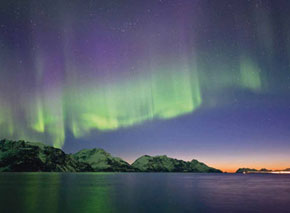Colors Of The Northern Lights
The three main colors of the northern lights are green, blue, and red. There maybe hues of other colors but these are the more prominent colors.
What causes the colors of the northern lights?
The colors of the northern lights are determined by the gases found in the atmosphere of the earth along with the various solar particles that collide with the gases at different height levels.
Explanation of the colors:
- When the gases collide with solar particles above 185 miles with oxygen, which is the most common gas the color will be red. This is one of the rarest colors seen in the northern lights.
- The most common color seen with the northern lights is green or a yellowish green. This occurs when the solar particles collide with oxygen between 60 to 185 miles.
- On the outer part of the northern lights, known as the auroral curtains you will find nitrogen, which helps to create the red light that is seen at around 60 miles.
Gases such as helium and hydrogen are very high in the atmosphere which are unseen by the human eye creating purple and blue colors at the time of collision.
How are the colors of the northern lights created?
Sunlight appears as white as it gives off all colors. The spectrum of light that is associated with the northern lights is restricted. The northern lights are caused by solar particles that are charged in the solar wind that collide with atoms and ions in the atmosphere. The collision makes the atoms energized. As the atoms are returning to their normal energy levels, they give off a visible light wavelength that creates the colors we see when viewing the northern lights.
The colors of the northern lights are dependent on the wavelength of the light that is emitted. The electrical state, the gas, and the energy of the solar particle that collides with the gas determine this occurrence. The atmosphere is made up of mostly oxygen and nitrogen, which helps to create the spectrum. Oxygen will bring about the colors of green and red while nitrogen brings out the blue and darker reds.
The majority of the colors seen with the northern lights are a yellowish green but along the lower edges, it is possible to see red tails. If the sun lights up the top edges it is possible to see a light blue color. Once about every ten years a dark red color is visible from top to bottom. Sometimes pink hues are noticed in the lower area.
Does altitude affect the colors of the northern lights?
Yes, the colors are seen differently according to where they occur in the altitude. Green is the most common color seen which occurs at 60 to 185 miles, red is seen above 185 miles, and blue is seen at 75 miles when the solar particles collide with oxygen.
The colors of the northern lights are affected by the gases and the altitude at which the collision occurs.

